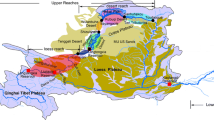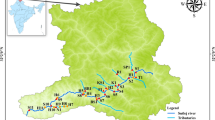Abstract
With a mean annual flow of 5.9×1011m3yr−1 and sediment load of 1600x1012gyr−1 the Ganges river ranks second and third, respectively, in terms of water flow and sediment load among the world's rivers. Considering the enormous sediment transport by Ganges to the Bay of Bengal, a study was conducted on the size distribution and mineral characteristics of the suspended sediments of the Ganges river and is reported here. Most of the sediment load has a size range between <4–5.75 φ). The sediments are mostly medium to coarse silt and are poorly sorted. Mica dominates among the clay minerals, followed by chlorite, vermiculite, kaolinite, and smectite. Due to differences in geology, smectite becomes a major clay mineral in downstream rivers. At Calcutta, the clay mineral transport in millions of tons per year is 18,464, 8000, and 2147, for mica, smectite, and chlorite, respectively.
Similar content being viewed by others
References
Abbas N and Subramanian V (1984) Erosion and sediment transport in the Ganges river basin (India). J Hydrol 69:173–182
Bhargava GP, Pal DK, Kapoor BS, and Goswami SC (1981) Characteristics and genesis of some sodic soils in the Indo-Gangetic alluvial plains of Haryana and Uttar Pradesh. J Indian Soc Soil Sci 29:61–70
Biscaye PE (1964) Distinction between chlorite and kaolinite in recent sediments by x-ray diffraction. Am Mineral 49:1281–1289
Biscaye PE (1965) Mineralogy and sedimentation of recent deep sea clay in the Atlantic Ocean and adjacent seas and oceans. Geol Soc Am Bull 76:803–832
Chakrapani GJ and Subramanian V (1994) Grain size distribution and mineralogy of suspended sediments of Mahanadi river. J Geol Soc India 44:541–546
Gibbs RJ (1965) Error due to segregation in quantitative clay mineral x-ray diffraction mounting techniques. Am Mineral 50: 741–751
Gibbs RJ (1967) The geochemistry of the Amazon river system. Part I. The factors that control the salinity and composition and concentration of suspended solids. Geol Soc Am Bull 78:1203–1232
Griffin JJ, Windom H, and Goldberg ED (1968) The distribution of clay minerals in the world ocean. Deep Sea Res 15:433–459
Handa BK (1972) Geochemistry of the Ganga river water. Indian Geohydrol 2:71–78
Jha PK, Vaithiyanathan P, and Subramanian V (1993) Mineralogical characteristics of the sediments of a Himalayan river: Yamuna river—a tributary of the Ganges. Environ Geol 22:13–20
Krishna Murty CR (1989) Rivers and their environmental significance. In: Ganga — a scientific study. Published for The Ganga Project Directorate. New Delhi: Northern Book Centre. 246 pp
Krishnaswami S, Trivedi JR, Sarin MM, Ramesh R, and Sharma KK (1982) Strontium isotopes and rubidium in the Ganga-Brahmaputra river system: Weathering in the Himalaya, fluxes to the Bay of Bengal and contributions to the evolution of oceanic87Sr/86Sr. Earth Planet Sci Lett 109:243–253
Matter A (1974) Burial diagenesis of pelitic and carbonate deep-sea sediments from Arabian Sea In: Whitmarsh SB and Wesser OE (Eds), Initial Reports. Deep Sea Drilling Projects (DSDP). vol 23. New York
Milliman JD and Meade RH (1983) World-wide delivery of river sediments to the oceans J Geol 91:1–21
Murty PSN and Rao KS (1989) Clay mineralogy of Vishakhapathnam shelf sediments, east coast of India. Mar Geol 88:153–165
Naidu AS, Mowatt TC, Somayajulu BLK, and Rao KS (1985) Characteristics of clay minerals in the bed loads of major rivers of India. In: Degens ET, Kempe S, and Herrera R (Eds), Proceedings, 3rd international workshop on transport of carbon and minerals in major rivers. Hamburg: SCOPE/UNEP. pp 559–568
Raymahasay BC (1970) Characteristics of stream erosion in the Himalayan region of India. In: Proceedings, symposium on hydrogeochemistry and biogeochemistry, vol 1. Washington, DC: Clark, pp 82–89
Richey JE (1983) Interactions of C, N, P and S in river systems: A biogeochemical model. In: Bolin B and Cook RB (Eds), The major biogeochemical cycles and their interactions, SCOPE 21. Chichester: John Wiley & Sons, pp 365–383
Sarin MM and Krishnaswami S (1984) Major ion chemistry of the Ganga-Brahmaputra river systems, India. Nature 312:538–541
Sarin MM, Krishnaswami S, Dilli K, Somayajulu BLK, and Moore WS (1989) Major ion chemistry of the Ganges-Brahmaputra river system: Weathering processes and fluxes to the Bay of Bengal. Geochim Cosmochim Acta 53:997–1009
Subramanian V (1980) Mineralogical input of suspended matter by Indian rivers to the adjacent areas of the Indian Ocean Mar Geol 36:M29-M34
Walling DE and Webb BW (1983) Patterns of sediment yield. In: Gregory KJ (Ed), Background to paleohydrology. New York: John Wiley. pp 69–100
Author information
Authors and Affiliations
Rights and permissions
About this article
Cite this article
Chakrapani, G.J., Subramanian, V., Gibbs, R.J. et al. Size characteristics and mineralogy of suspended sediments of the Ganges river, India. Geo 25, 192–196 (1995). https://doi.org/10.1007/BF00768548
Received:
Accepted:
Issue Date:
DOI: https://doi.org/10.1007/BF00768548




